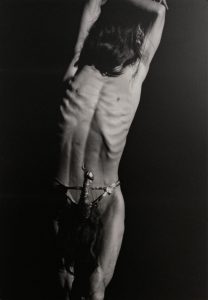Sensuality (Updated: Mar 06, ’21)
“[Hijikata] staged the body in all its immanence, in ecstasy, as a site of pleasures and pain, disturbed by objection and cruelty.” – Catherine Curtin

The Cambridge dictionary defines sensuality as: “the expression or suggestion of physical, especially sexual, pleasure or satisfaction.” The terms sexuality and eroticism may also come to mind. Because all these terms hold a huge association to the body, it is not surprising that we can use this qualia for our movement practice. Already even, courting or erotic acts are viewed as a form of dance.
George Bataille appeared to have placed eroticism at the extreme end of living itself. He stated in his work Eroticism: Death & Sensuality: “Of eroticism, one can say that it is the approval of life even to the point of death.”² This may be thought of as an extreme form of acceptance or “yes, and” which may bring to mind a deep resonance. Resonance is what must be found in order to dance beyond mere pantomime.
Bataille’s view rings familiar to that of Antonin Artaud’s view of the cruel and essential theatre where something immediate or bloody real finally happens, a “hungering after life, cosmic strictness, relentless necessity, […] a living vortex engulfing darkness, […] a necessary pain without which life could not continue.”3, 4
When one digs deep into one’s own psyche or subconscious body, one may reach this point of ecstasy.
Catherine Curtin states that “eroticism distorts the reproductive purpose of sexuality.”5 This view in essence appears to deterritorialize sexuality, expanding its use. At the extreme, Deleuze and Guattari really expand it, when they stated, “Sexuality is everywhere: the way a bureaucrat fondles his records, a judge administers justice, a business man causes money to circulate, the way the bourgeoise fucks the proletariat and so on.”6
In club or rave culture, the music and dance floor can be the means to a full sensual body release. Music can be said to be the lover. In butoh, the space and/or subconscious itself can be the lover.
Yet, the very beginnings of butoh share space with both the club atmosphere and burlesque shows. The shows not only served earning a living but also was a way to create new dance. Both butoh and the burlesque show share the emphasis of body itself with not so much a narrative.7 In Catherine Cutin’s words, “The Butoh stage became a site to deconstruct sexual signifiers and reconstruct ambiguous identities, as androgynous bodies were incorporated.”8
Exercise 1: Invisible Partner
There is so much material in the sex act itself. Use this material to inspire the dance. For instance, the shaking/rocking momentum can be picked up. The secret or mystery may reside in what is sexing you.
Exercise 2: Erogenizing Non-erogenous Zones
Resonate and utilise parts of the body that have the least sensation or association with sensuality or pleasure. Breasts and/or genitals can even make their way in other parts of the body that can be shaken like at a Cabaret or strip club.
Exercise 3: Body Part Romance
One part of the body is in romance with another part of the body.
Exercise 4: Deterritorialized Thrust
In sexuality, the thrust may be associated with the pelvis and coitus, but we can thrust any part of the body with the same qualia.
Exercise 5: Deterritorialized Erotic Breath & Sound
A variety of breathing patterns and sounds can come from the sex act. Be inspired by these to use in your dance. Edit accordingly as if these are being run through a synthesizer. Sometimes, maybe most of the times, you do not want to reveal the secret, and you want to keep things a bit veiled or obscured.
